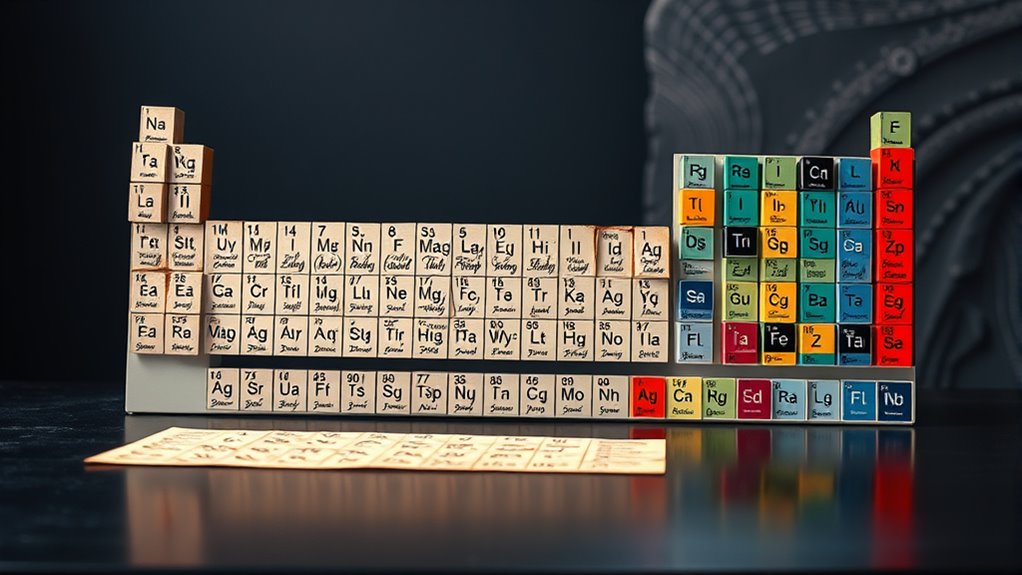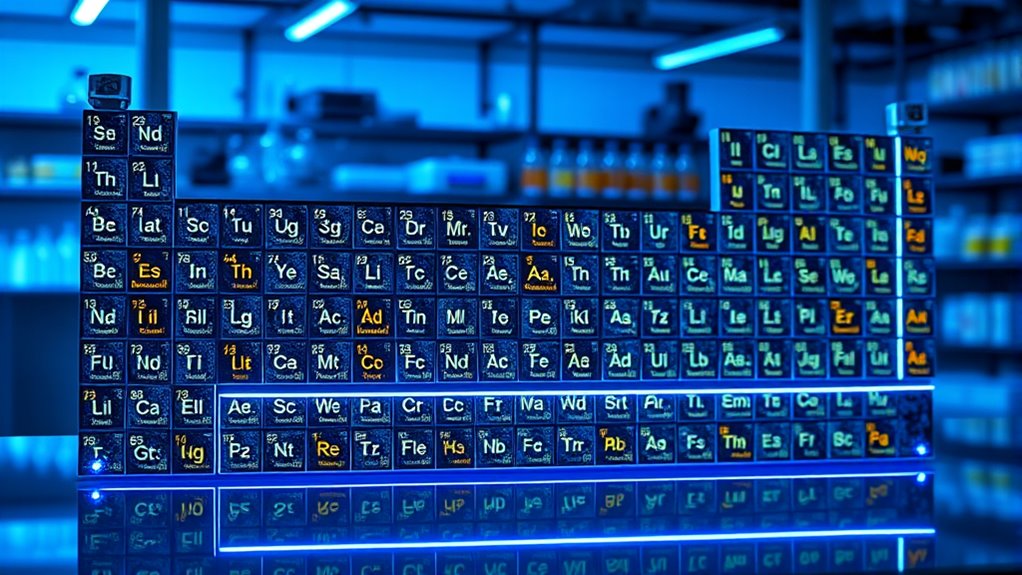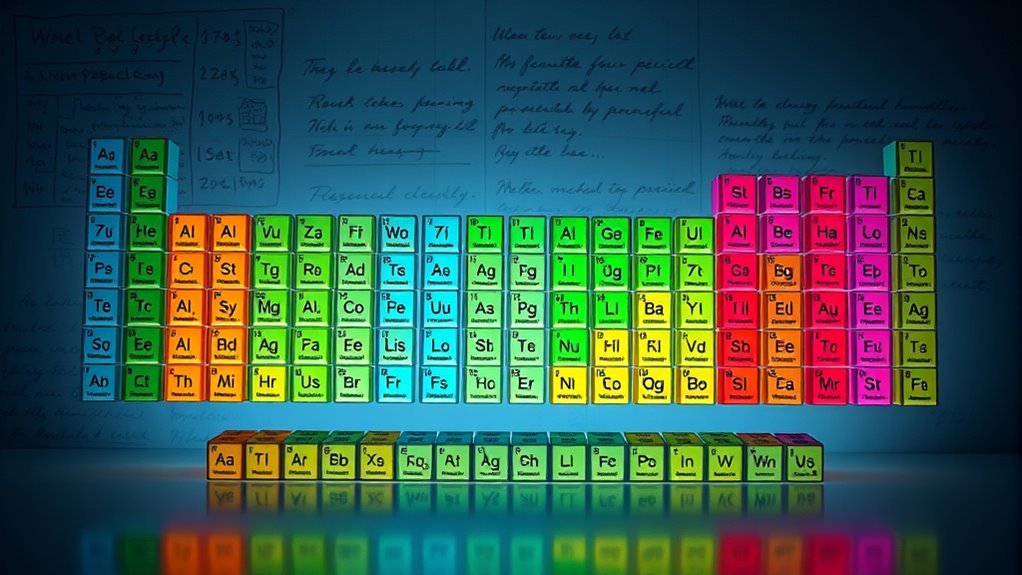The periodic table evolved from early ideas about indivisible atoms to a structured system based on atomic properties. Mendeleev organized elements by increasing atomic weight and noticed periodic patterns, even leaving gaps for undiscovered elements. Moseley’s discovery of atomic numbers confirmed that the number of protons defines each element, leading to the modern layout. Advances like the discovery of actinides and synthesis of superheavy elements keep shaping its future—explore further to see how it continues to grow.
Key Takeaways
- Mendeleev organized elements by increasing atomic weight and periodic chemical properties, predicting missing elements and gaps in the table.
- Moseley’s experiments with X-ray spectra established atomic number as the fundamental property for organizing elements.
- The discovery of actinides and superheavy elements expanded the periodic table, leading to modern structural classifications.
- The periodic table evolved from simple groupings to a sophisticated layout based on electron configurations and blocks (s, p, d, f).
- Ongoing research and technological advances continue to refine, extend, and deepen understanding of the periodic table’s structure and significance.
The Birth of the Periodic Table: Early Ideas and Foundations

The development of the periodic table began with early ideas about elements and atomic theory that laid the groundwork for modern classification. Over 5,000 years, the concept of elements evolved from basic observations to scientific definitions. Early atomic theory proposed atoms as indivisible particles, influencing how chemists grouped substances. By the 19th century, scientists understood that elements couldn’t be broken down chemically and started measuring atomic weights, which helped relate elements through measurable properties. Recognizing chemical properties and valence led to initial groupings, like Dobereiner’s triads, which showed that atomic weights of middle elements were averages of neighboring ones. These early ideas set the stage for more systematic approaches, highlighting the recurring patterns and relationships among elements that would later form the foundation of the periodic table. The discovery of atomic weights and the periodicity of properties established a systematic classification that would eventually evolve into the modern periodic table, emphasizing the importance of periodic trends in understanding elemental relationships. Additionally, the recognition of periodic patterns in properties was crucial in organizing elements into a coherent and predictive framework.
Mendeleev’s Breakthrough: A Systematic Approach to Element Organization

Building on earlier efforts to classify elements based on chemical properties and atomic weights, Dmitri Mendeleev developed a groundbreaking system that organized known elements in a coherent and predictive framework.
He arranged 63 to 70 elements primarily by increasing atomic weight while considering their chemical behavior. Recognizing periodicity, he grouped similar elements into vertical columns, or families.
Mendeleev prioritized chemical properties over strict atomic weight order, swapping elements like tellurium and iodine to preserve patterns. He left gaps for undiscovered elements, predicting their properties and atomic weights, which later proved accurate with discoveries like gallium, scandium, and germanium.
His flexible approach foreshadowed the atomic number concept and transformed chemistry into a predictive science.
The Atomic Number Revolution: Moseley’s Contribution to Periodic Structure

Moseley’s discovery transformed our understanding of the periodic table by establishing atomic number as a fundamental physical property of elements. Before his work, atomic numbers were seen as arbitrary labels, not linked to measurable properties.
Moseley’s experiments with X-ray spectra revealed a precise relationship—known as Moseley’s Law—between X-ray frequencies and atomic numbers, confirming that atomic number equals the number of protons in an atom’s nucleus. This shift corrected irregularities in Mendeleev’s table, especially for isotopes with different atomic weights. His work also provided a quantitative basis for identifying elements more accurately, reinforcing the importance of atomic number over atomic weight alone.
It allowed elements to be ordered by atomic number, aligning with periodic law and predicting missing elements more reliably. Moseley’s work also supported nuclear models, linking atomic structure with chemical properties and paving the way for modern atomic theory. Atomic number as a key property further unified the understanding of element behavior and contributed to the development of periodic classification systems that are used today.
Expanding Horizons: The Discovery of Actinides and the Synthesis of New Elements

As scientists explored the periodic table beyond the traditional elements, they uncovered a new group known as actinides, whose discovery expanded our understanding of heavy elements. Uranium and thorium, discovered in the late 18th and early 19th centuries, marked the first known actinides.
Actinium and protactinium followed, though their identification was complex due to their scarcity and similarities to lanthanides. The term “actinide” was introduced in 1937, and producing pure samples proved challenging until 1950. Production techniques have been crucial in isolating and studying these elusive elements.
Actinium and protactinium’s discovery was complex due to scarcity and similarities to lanthanides, with the term “actinide” introduced in 1937.
These elements played a pivotal role in nuclear fission discoveries, leading to nuclear energy and weapons. Natural sources like pitchblende and monazite contain actinides, which are extracted through complex processes. Advances in isolation methods have significantly improved our ability to study and utilize actinides.
Research into actinides has paved the way for synthesizing superheavy elements using particle accelerators, expanding the periodic table further.
Modern Layout and the Challenges of Heavy Elements

The modern layout of the periodic table organizes elements into seven periods and eighteen groups, reflecting their electron configurations and chemical properties. You’ll notice that each period corresponds to a new electron shell filling, while elements in the same group share similar behaviors due to their valence electrons.
The table is divided into four blocks—s, p, d, and f—each representing different electron subshells, influencing reactivity and metallic character. Heavy elements pose unique challenges, as their electron configurations are affected by relativistic effects, which can alter expected properties. Changing Gears on a Gravel Bike Synthesizing these elements is complex, often relying on advanced technologies and theoretical models for prediction. Despite these hurdles, the table remains a flexible, evolving tool, continually refined as new elements are discovered and our understanding deepens.
The Periodic Table Today: Recognitions and Ongoing Discoveries

Today, the periodic table stands as one of the most important and widely recognized tools in modern chemistry, representing the recurring patterns of element properties. You see it used worldwide in classrooms and labs, guiding discoveries and predictions.
Its scientific significance is clear, helping researchers predict properties of unknown elements and enabling breakthroughs like the synthesis of new materials. Recognized globally by IUPAC, it’s also a cultural icon, appearing in media and art.
The table’s predictive power led to discoveries like gallium and germanium, earning Nobel Prizes. Its organization into groups, periods, and blocks reflects electron configurations, aiding understanding of chemical behavior.
Ongoing efforts focus on creating superheavy elements, pushing the boundaries of knowledge and confirming the table’s enduring relevance in science.
The Impact and Future of the Periodic Table in Science

Have you ever wondered how the periodic table continues to shape scientific progress across multiple disciplines? It provides quick access to essential element properties like atomic mass, electronegativity, and atomic radius, critical for chemical analysis and industrial processes.
The table serves as a foundation for chemistry, physics, engineering, and environmental science, helping scientists understand elemental behavior and develop new materials. It also drives research into atomic structures, guides the discovery of new elements, and inspires innovative computational models.
In education, it makes complex concepts accessible, fostering interest in STEM fields worldwide. Future developments include discovering superheavy elements and integrating AI for predicting novel compounds, ensuring the periodic table remains indispensable for scientific advancement and technological innovation.
Frequently Asked Questions
How Did Early Periodic Tables Influence Modern Chemical Theories?
Early periodic tables laid the foundation for modern chemical theories by highlighting recurring properties among elements. You can see how grouping elements by properties, like triads, helped predict behaviors and relationships, which influenced the development of the periodic law.
These early insights led to organizing elements by atomic number today, enabling you to understand reactivity, predict new elements, and advance materials science, making chemistry a more systematic and predictive science.
What Challenges Arise in Synthesizing Superheavy Elements Today?
You face several challenges when synthesizing superheavy elements today. Technical limitations restrict isotope production, and the need for high beam intensities makes experiments resource-heavy.
Short half-lives of these elements complicate detection, while precise reaction conditions are hard to control.
Additionally, the high costs, extensive labor, and technological constraints limit large-scale production, making the process slow, expensive, and difficult to achieve consistently.
How Does the Periodic Table Adapt to New Scientific Discoveries?
You’d think the periodic table is set in stone, but it’s actually a rebellious teenager constantly changing. When you discover new elements, especially synthetic or superheavy ones, you add them, reshaping the table without breaking its rules.
It reorganizes itself based on atomic number, electron configurations, and properties, proving science’s flexibility. So, instead of a boring chart, it’s a lively, evolving tool, always ready for the next scientific breakthrough.
What Role Do Isotopes Play in Refining Element Placement?
Isotopes help refine element placement by providing detailed atomic weight data, which improves classification accuracy. You can see isotope patterns that differentiate elements with similar masses and understand their stability or radioactivity.
This information enhances the periodic table’s precision, especially for elements with multiple isotopes. By analyzing isotope distributions, you gain insights into an element’s origin and properties, making your periodic table more informative and useful for scientific and practical applications.
Could the Periodic Table Undergo a Fundamental Structural Change in the Future?
Imagine your favorite puzzle, where every piece fits perfectly—that’s how the periodic table currently functions. But in the future, new superheavy elements might require reshaping this puzzle entirely.
Advances in particle accelerators and quantum theory could lead to a structural overhaul, perhaps adding new blocks or changing organization principles. You might see the table expand beyond what you now consider complete, reflecting a deeper understanding of atomic behavior.
Conclusion
As you reflect on the evolution of the periodic table, imagine it as a grand tapestry woven with discovery and innovation. From Mendeleev’s early patterns to today’s cutting-edge elements, each thread reveals humanity’s relentless pursuit of understanding the universe. The table continues to grow, like an eternal garden of knowledge, inviting you to explore its endless mysteries. Embrace this journey, for the table’s story is a demonstration of your own curiosity and discovery.









